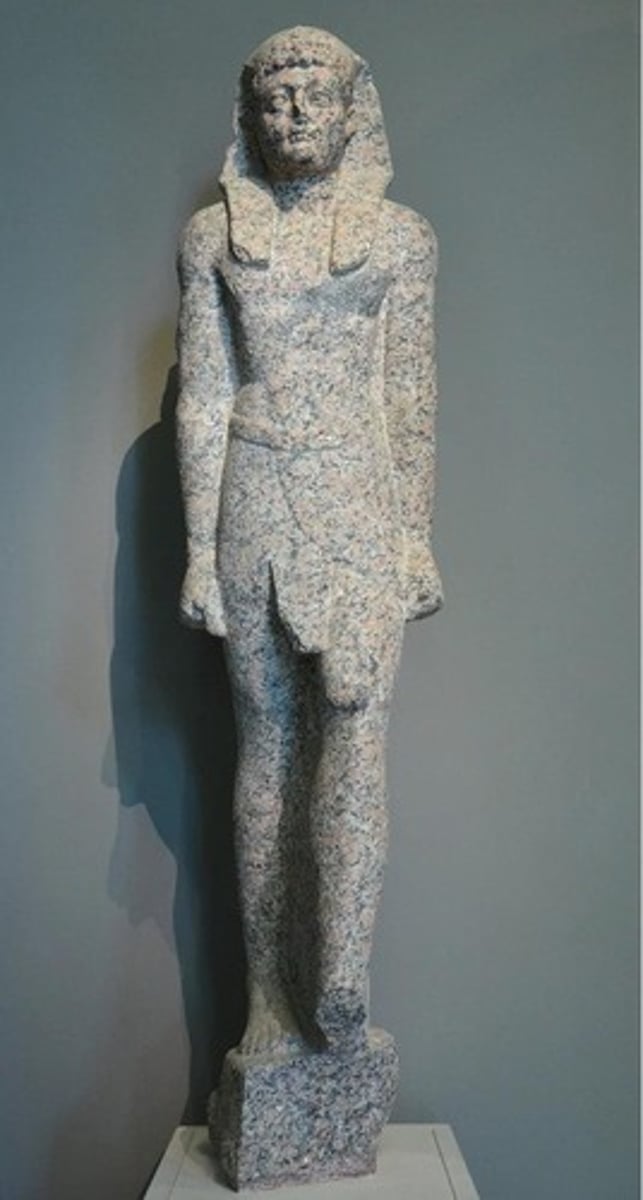Egyptian Architecture: Final Artwork
1/35
There's no tags or description
Looks like no tags are added yet.
Name | Mastery | Learn | Test | Matching | Spaced |
|---|
No study sessions yet.
36 Terms
Statue of Senwosret III, stone (quartzite), 12th dynasty, Middle Kingdom
- Indicative of a shift in royal ideology
- Lines on the forehead and around the lips, indents on the face
- More emphasis on the king being older
- Still not a portrait, still idealized, just in a different way
- Really big ears
- Obviously a king
- Headdress and snake on headpiece
- Some motifs are still the same
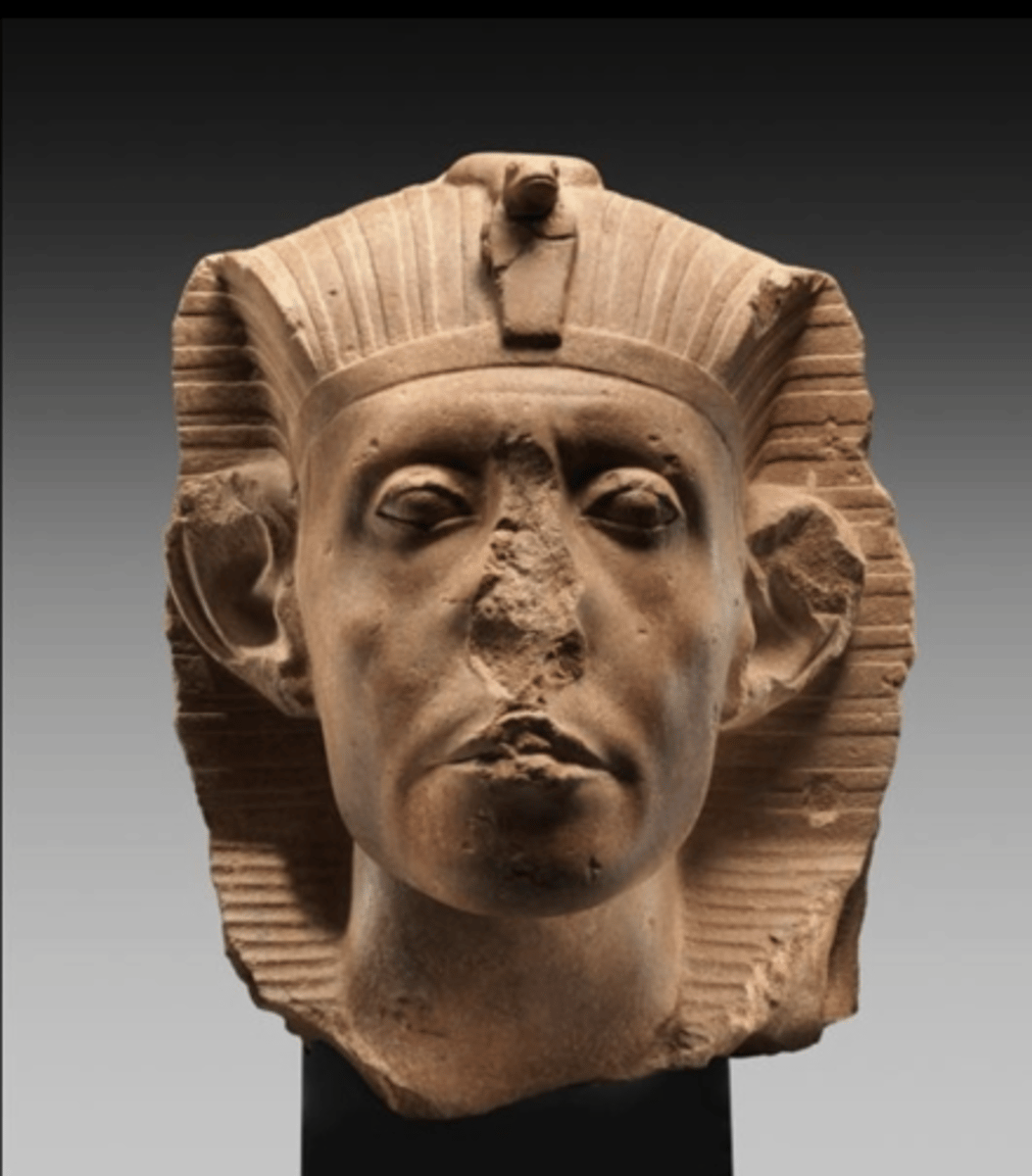
Senwosret II pyramid, Lahun, mudbrick and stone, 12th dynasty, Middle Kingdom
- Built of mudbrick instead of stone
- Not necessarily meant to last forever, unlike old kingdom pyramids
- Shift from focus on divine kingship to ties of kings to humanity
- Some stone, another explanation is that there is less money in the monarchy at this time, but seems too simple
- Officials still buried around the pyramid
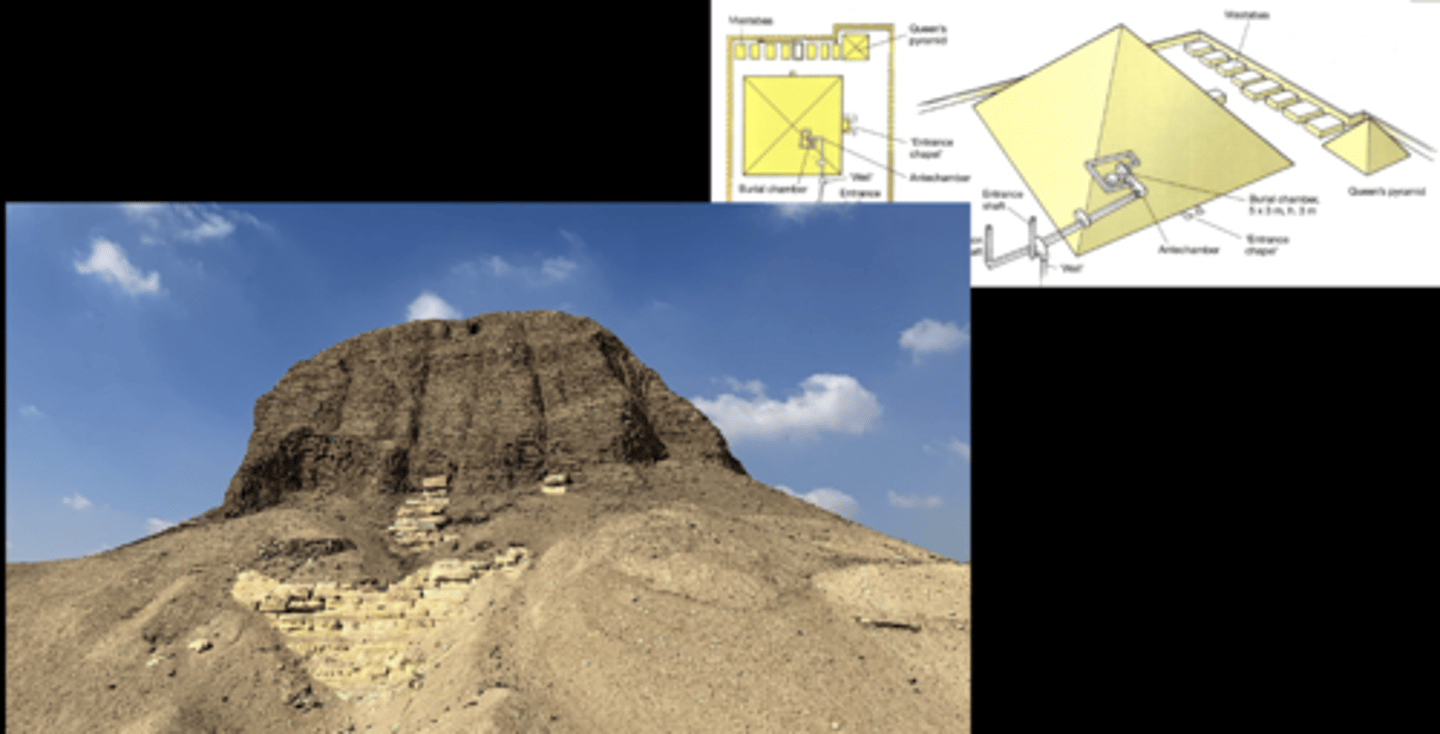
pectorals from the burial of Mereret (a royal woman from the reign of Senwosret III), gold and precious stones, Dashur, 12th dynasty, Middle Kingdom
- Pectoral = necklaces
- Precious stones used to differentiate different races of people
- Now, people connected to the king could also where symbols related to the king protecting egypt (smiting of enemies)
- Some of the most detailed jewelry from ancient egypt (why middle kingdom is considered the height of ancient egypt)
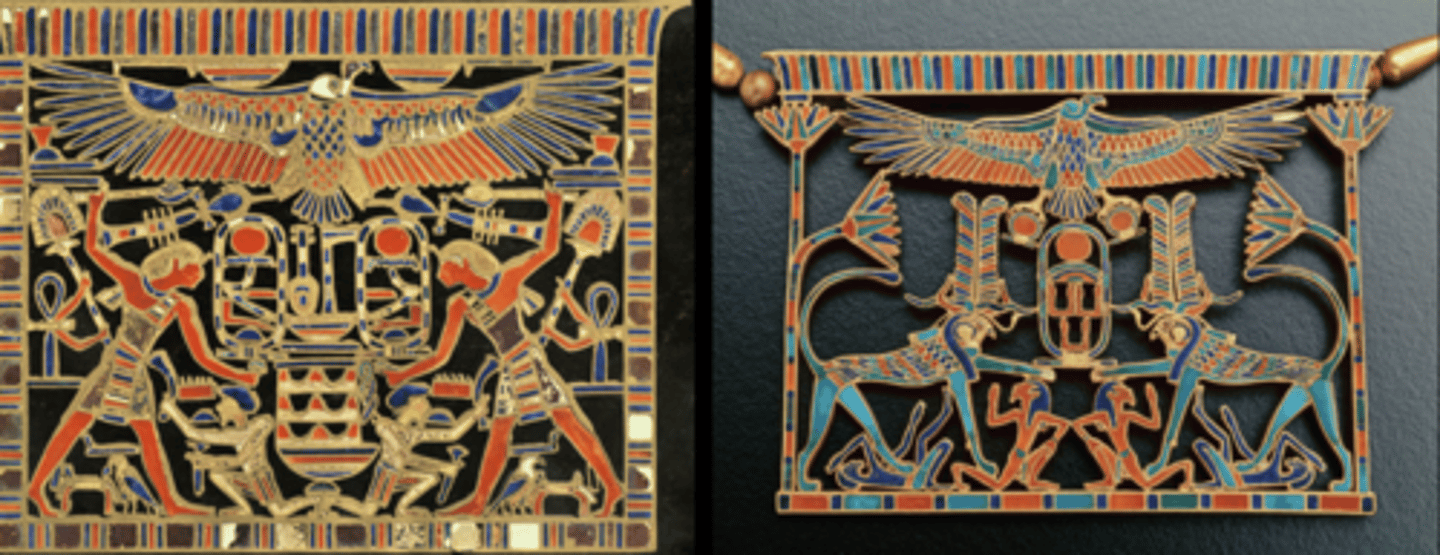
white chapel of Senwosret I at Karnak, limestone, 12th dynasty, Middle Kingdom
- Been completely reconstructed from fragments
- Senworset = important king for considering the divine during this period because he built divine temples everywhere
- Shrines/temples built to demonstrate divine right to rule
- Has both administrative and religious functions
- Lists of different regions of Egypt inscribed on the walls
- References taxation and lists of different goods
- See this a lot in temples of the new kingdom
- Religious function
- Building would have been used in divine processions
- Statue of the god which lived in the temple (temples were the houses of gods) would be taken out of the temple by priests and placed in something that looks like a boat on a shrine and carry it around; nonroyal individuals could then access the statue, but it was veiled, so not that much more interaction
- Priests depicted bald as symbol of purity needed to enter the chapel
- Chapel = resting point where priests can set the boat down then pick it up and continue the procession

Painting from the tomb of Djehutihotep, Deir el-Bersha, 12th dynasty, Middle Kingdom
- From a non-royal tomb
- Really big figure sitting on a fancy chair on a sled being dragged by a bunch of tiny figures (community dragging along really big statue of this guy to his tomb)
- Local festival dedicated to local figure rather than the king
- New to the middle kingdom, not present in old kingdom
- Really impressive tombs for community leaders

town of Lahun (Kahun), pyramid town of Senwosret II, founded in the 12th dynasty, Middle Kingdom
- Clear social divide between little houses on the left and big mansions on the right
- Houses not only occupied by nuclear families, but also by administrators and servants who also lived in the area
- Granary included in the houses 9huge granaries imply that other people were living in the house besides the nuclear family)
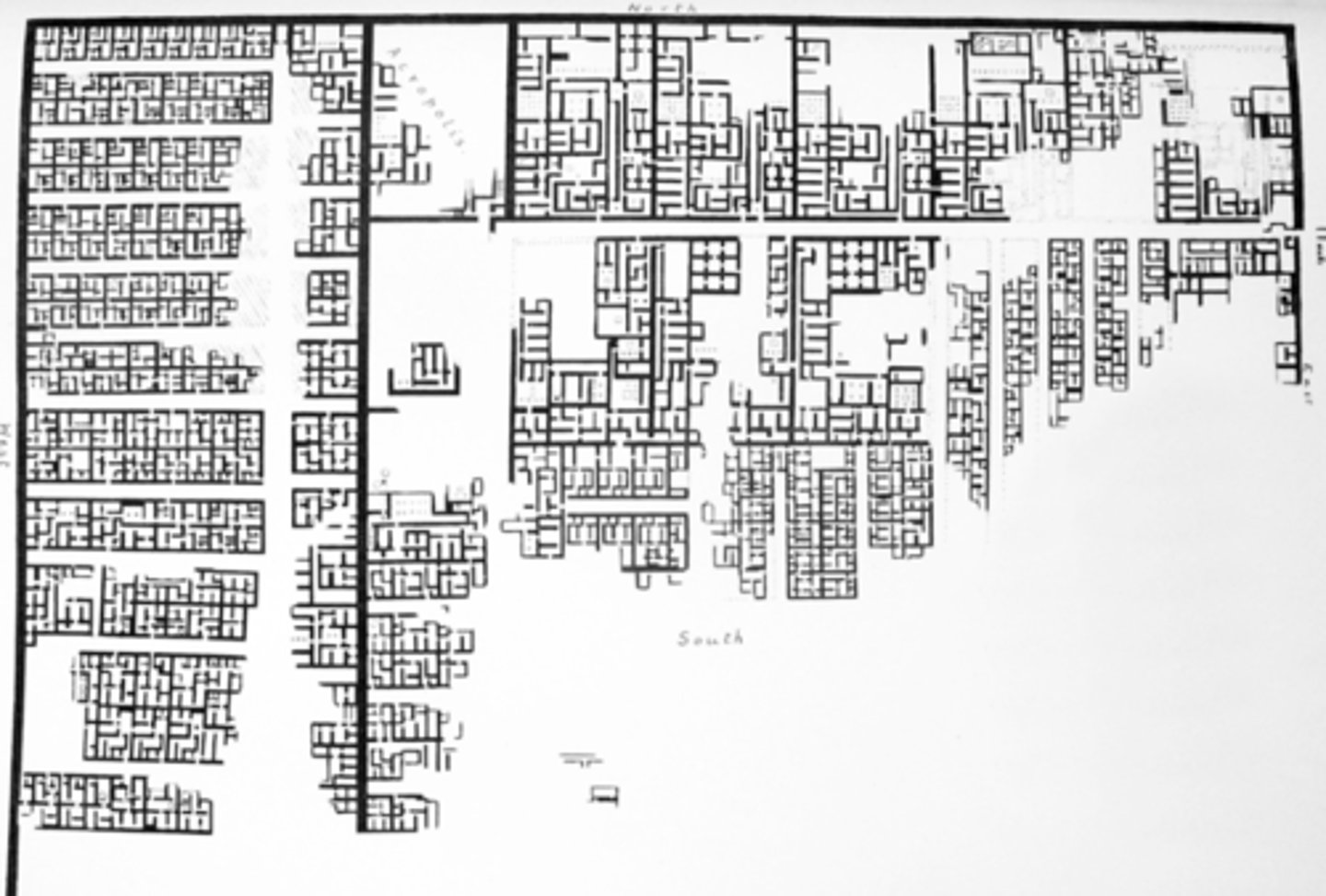
model of granary with scribes, tomb of Meketre, painted and carved wood, 12th dynasty, Middle Kingdom
- Same purpose as the carved statues and wall carvings carrying food and offerings for the tomb owner from the Old Kingdom
- Model of granary ensures that tomb owner has food for the rest of the afterlife
- Model of boat going to afterlife, woman bringing offerings, people fishing, etc...
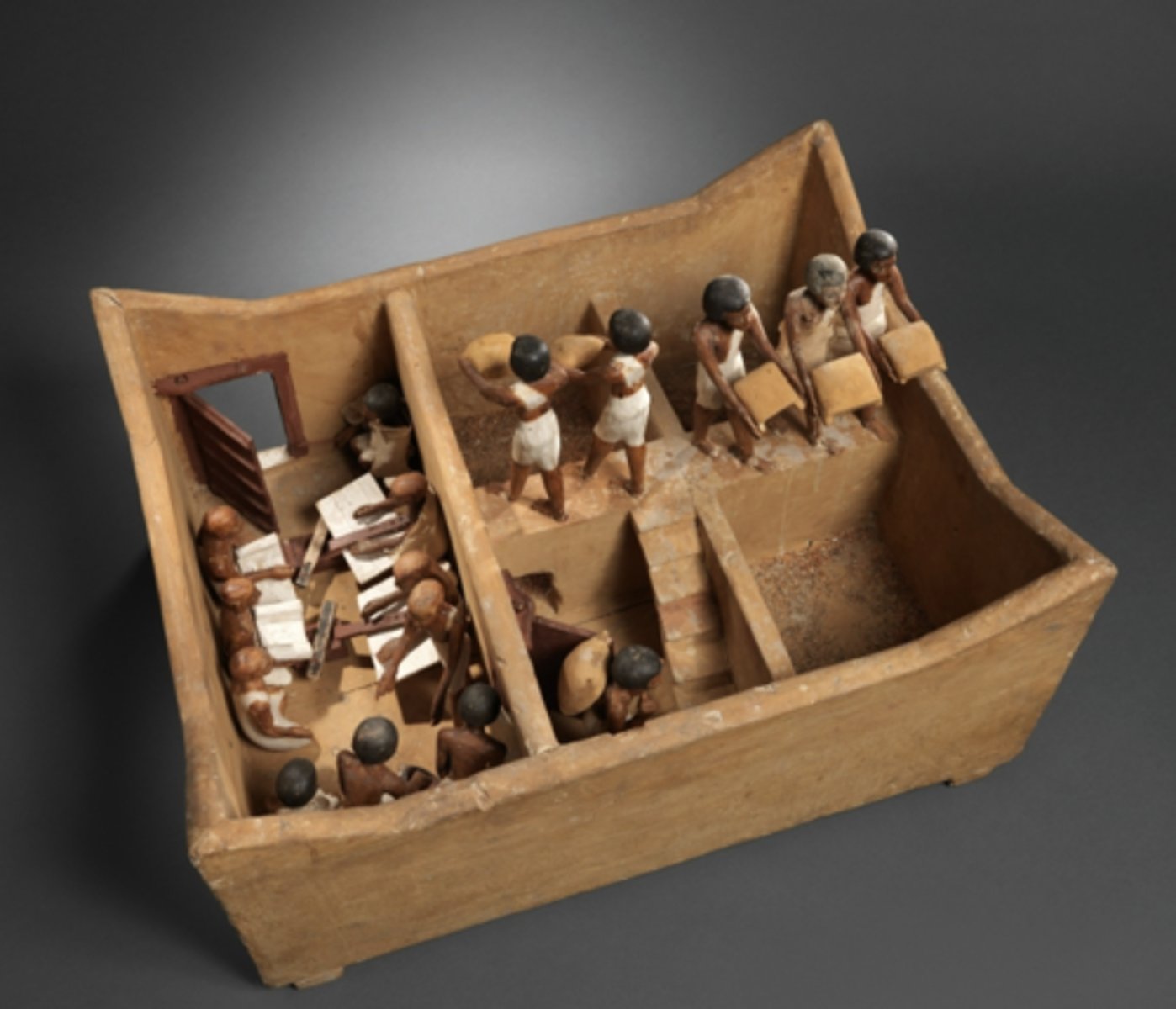
"magic wands", ivory, 12th dynasty, Middle Kingdom, found in tombs
- Looks like a boomerang
- Protective goddess of children and mothers holding a knife (hippo head, lion's limbs and paws, stylized crocodile tail on its back)
- Frog could = fertility
- Mythical animals
- Purpose of objects is debated
- Clearly used for something based on ware on tips
- Probably used to protect a mother during childbirth (priest takes wand and draws a circle in the sand around the mother)
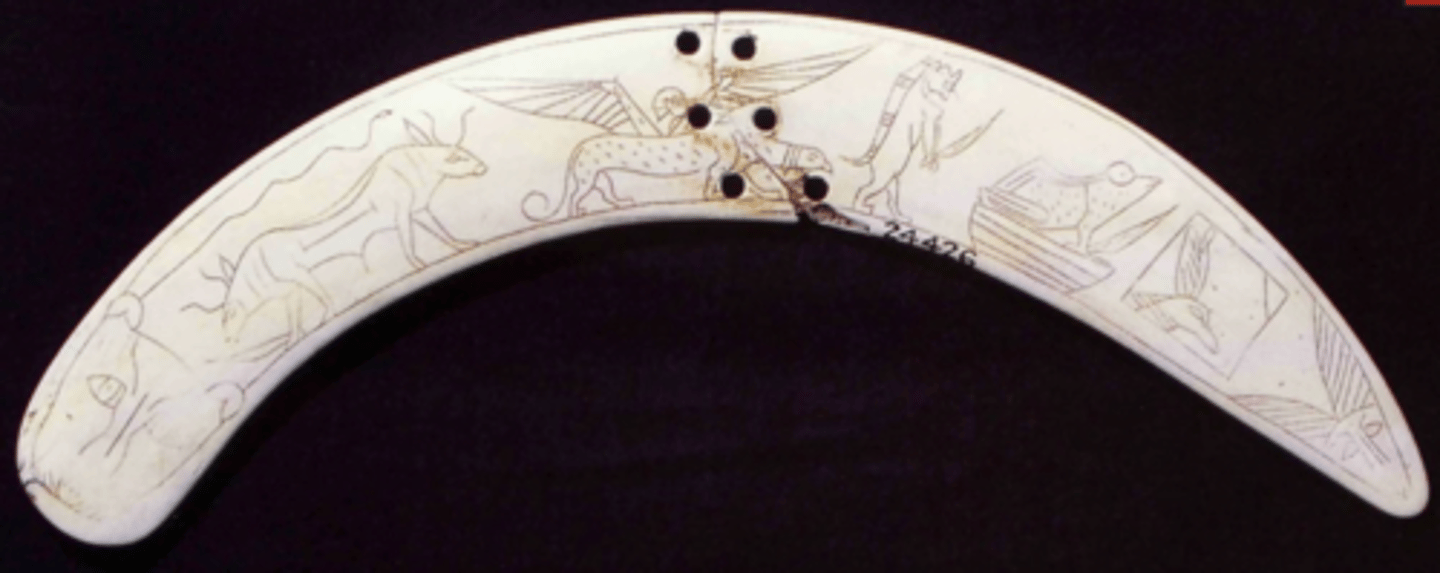
Nubian archers, carved and painted wood, model from a Middle Kingdom tomb
- Tomb model found in an Egyptian tomb, implies that it is not threatening to the tomb owner and is likely protective
- Displays Nubians
- Dark skin color
- Bows and arrows (Numbians known for being skilled archers)
- Patterned clothing
- Hair
- Nubians were a part of the Egyptian military during the Middle Kingdom, but texts from this time will often paint them in a poor light
- Contradictory
- Clearly Nubians were able to go into Egypt and live without conflict at this time
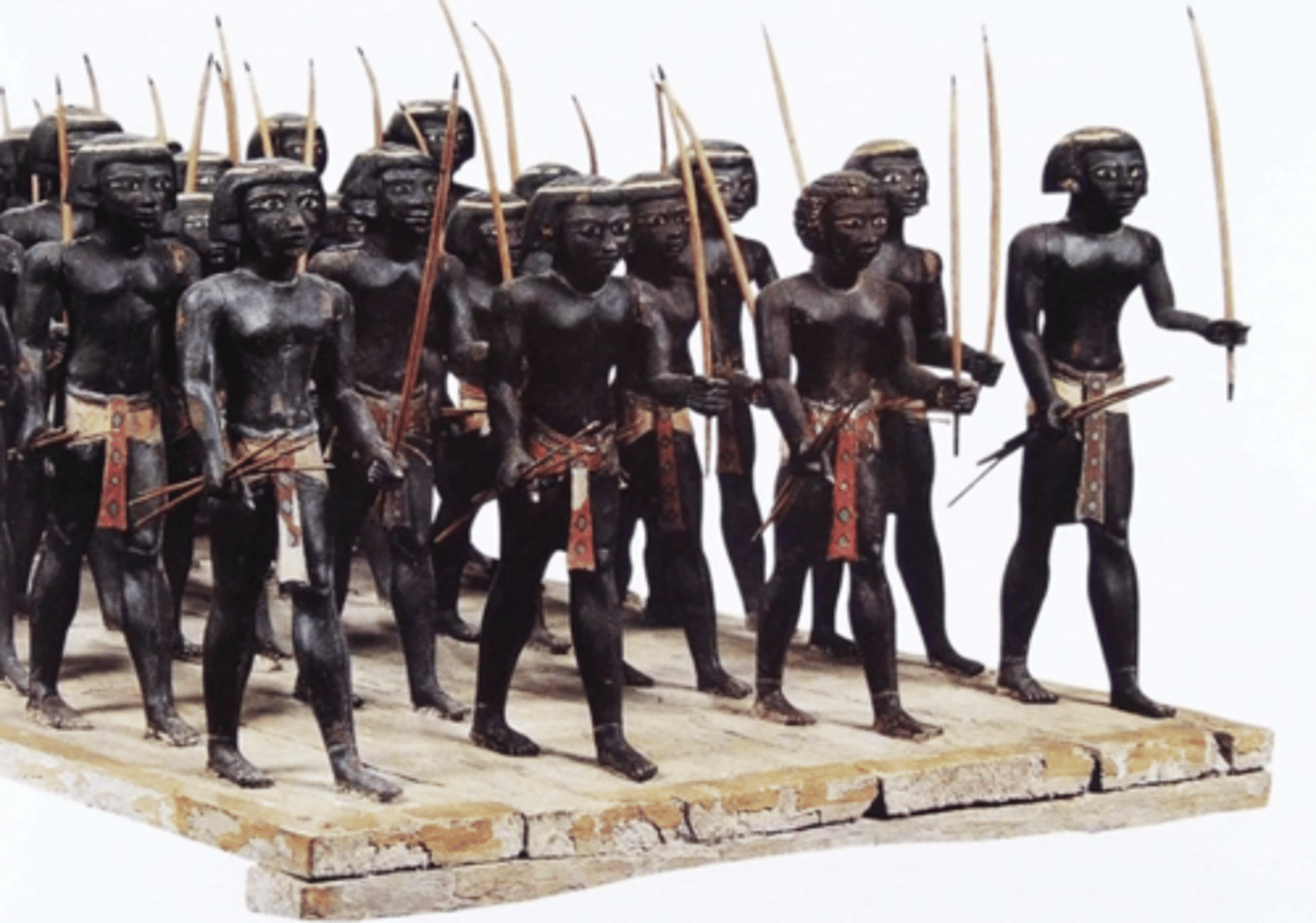
Buhen fortress, built by Senwosret I in the 12th dynasty, mudbrick, Nubia, Middle Kingdom
- Built in the first wave of fortress construction in Nubia
- Thick walls, built for defense against Nubia when there was no evidence that Nubia was even attacking Egypt
- Not going back and forth between Egypt and fortresses
- Living there, dying there, being buried there
- Almost mini Egyptian settlements in Nubia
- Senwosret I = first king to build these type of forts in Nubia
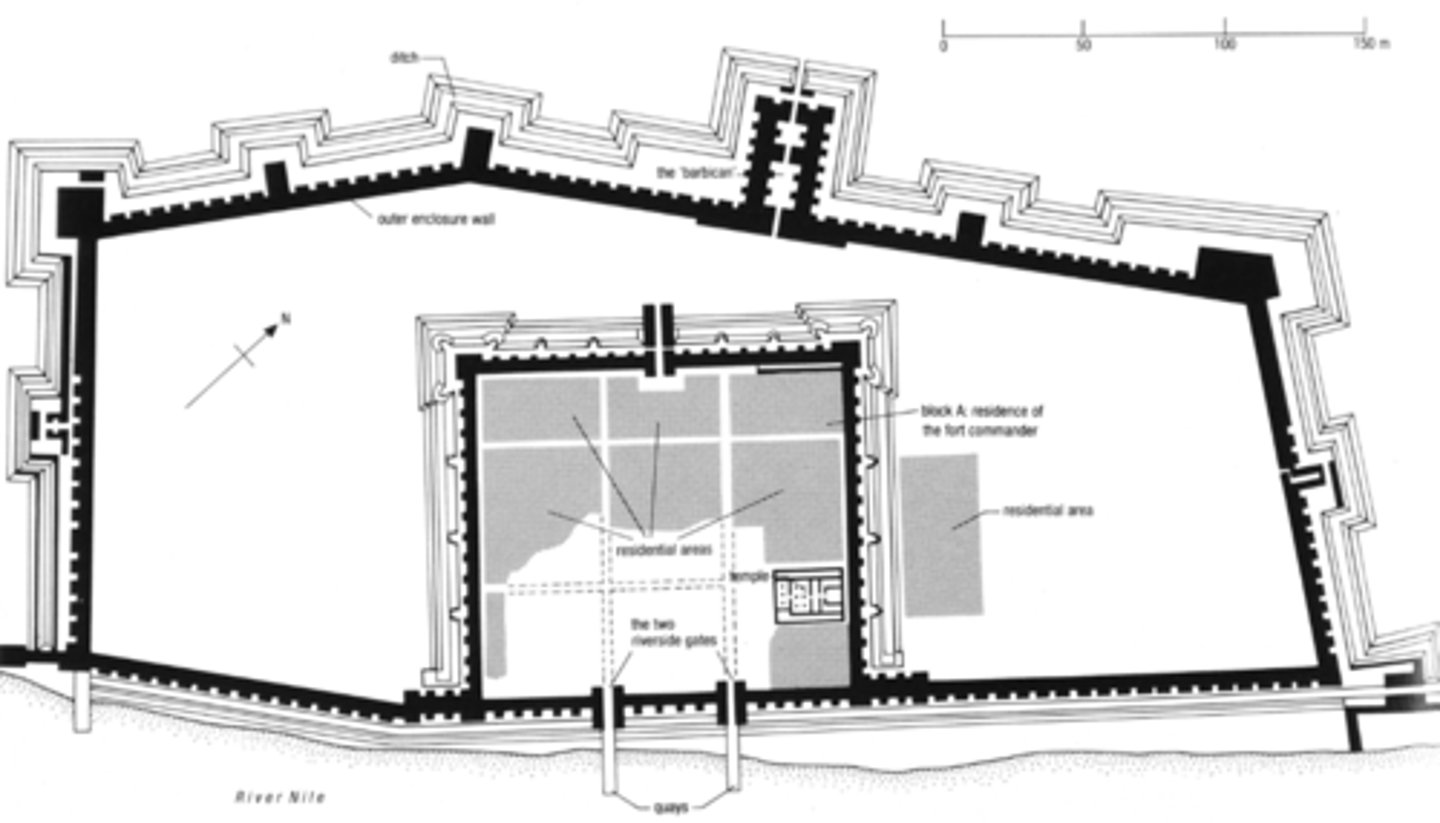
Uronarti Fortress, built by Senwosret III in the 12th dynasty, mudbrick, Nubia, Middle Kingdom
- Shaped weirdly because it had to adapt to the landscape
- Small, but had everything that an Egyptian who lived there would need
- Ceramics found at fortresses indicate what types of food people are eating
- We have both Egyptian ceramics and Nubian ceramics
- Suggests that Egyptian and Nubian people were eating together
- Nubians may have also been living at the fortress

statue of high-ranking Hyksos, limestone, from cemetery at Tell el-Dab'a, late Middle Kingdom
- Not an Egyptian
- Mushroom hair
- Similar mushroom hair to that seen on person being smited by king in a princess's pectoral
- Clothing style
- Patterning of paint on the clothing resembles the clothing of Adriatics in Egyptian artwork, not - Egyptian clothing
- Person holding foreign object (throw stick (very emblematic of the Adriatics for the Egyptians))
- Explicitly emphasizing that this person in an Adriatic
- Clearly a mix of Egyptian and not Egyptian traditions and iconography
- Clearly deliberately smashed and fragments spread out in cemetery
- Statue from a tomb in Ebla (Levant) looks really similar to this statue
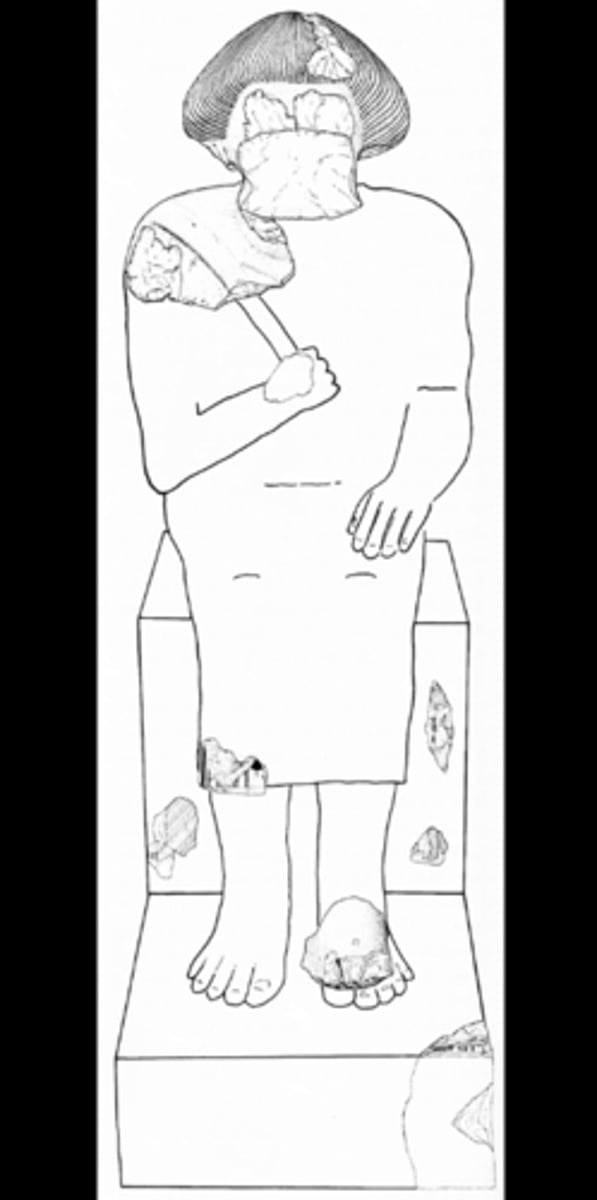
Western Deffufa (temple site), mudbrick, Karna, Second Intermediate Period
- Egyptian temples are built of stone and have a very different structure from this temple
- We do not know what they were doing in here in terms of ritual practices, but this seemed to be a center of ritual expression at Kerma
- Really advanced architectural practices demonstrated that are completely different from Egyptian architecture
- Indicates that the Nubians were really developed and sophisticated, which is not always how the Nubians are portrayed
- Nubian king portrayed like both an Egyptian and Nubian
- Wearing crown of Upper Egypt with the uraeus
- Holding a smiting stick (Egyptian)
- Also holding a bow (Nubian)
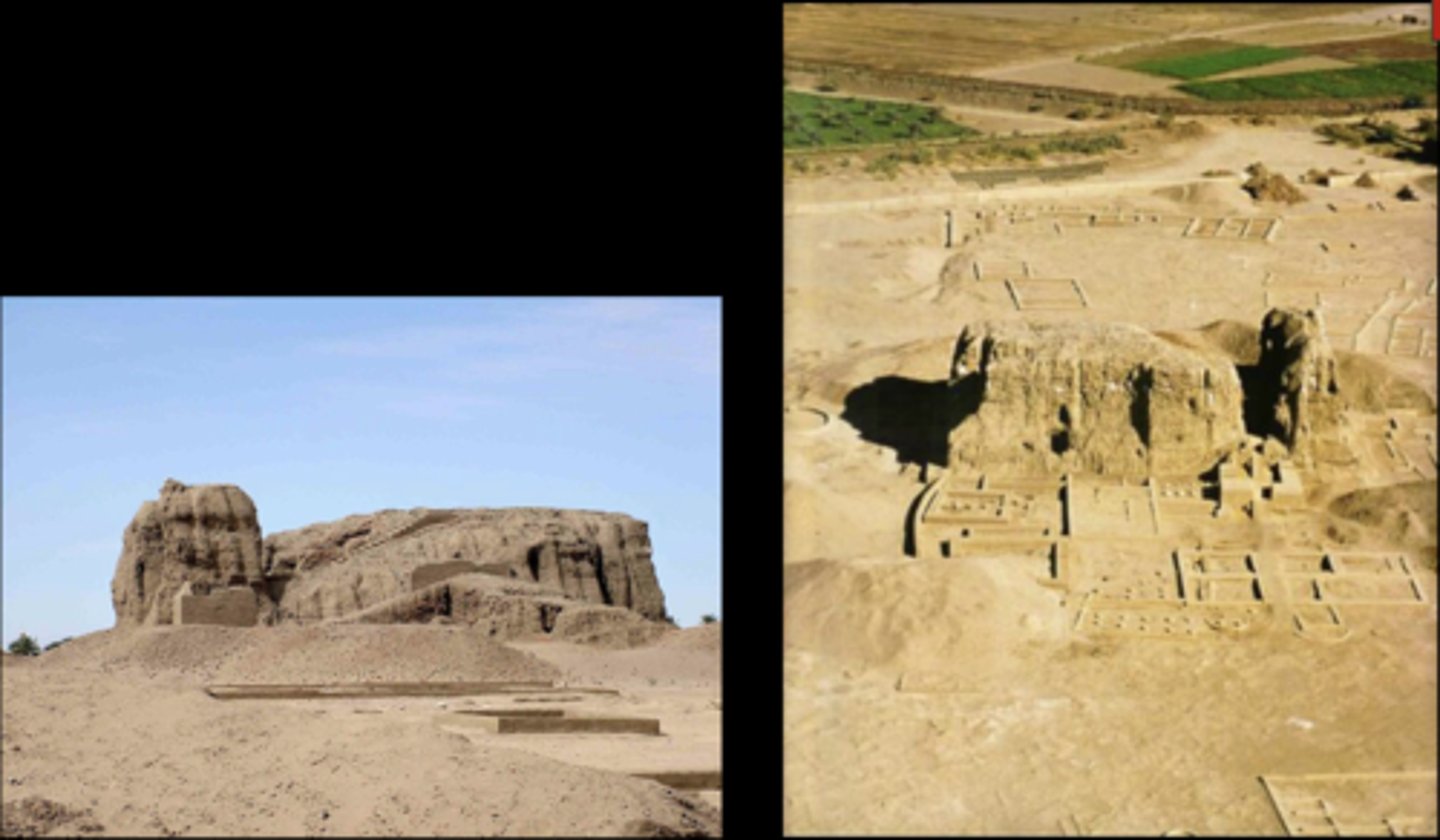
funerary assemblage of Ahhotep, Ahmose's mother, contains weapons, jewelry, found in her tomb, 17th dynasty, end of Second Intermediate Period/reunfication
- Ahmose gives his mom a lot of credit for keeping Egypt together during the reunification wars
- Golden flies in her tomb = high military honor
- highlights increased power/importance of royal women at this time, especially in politics
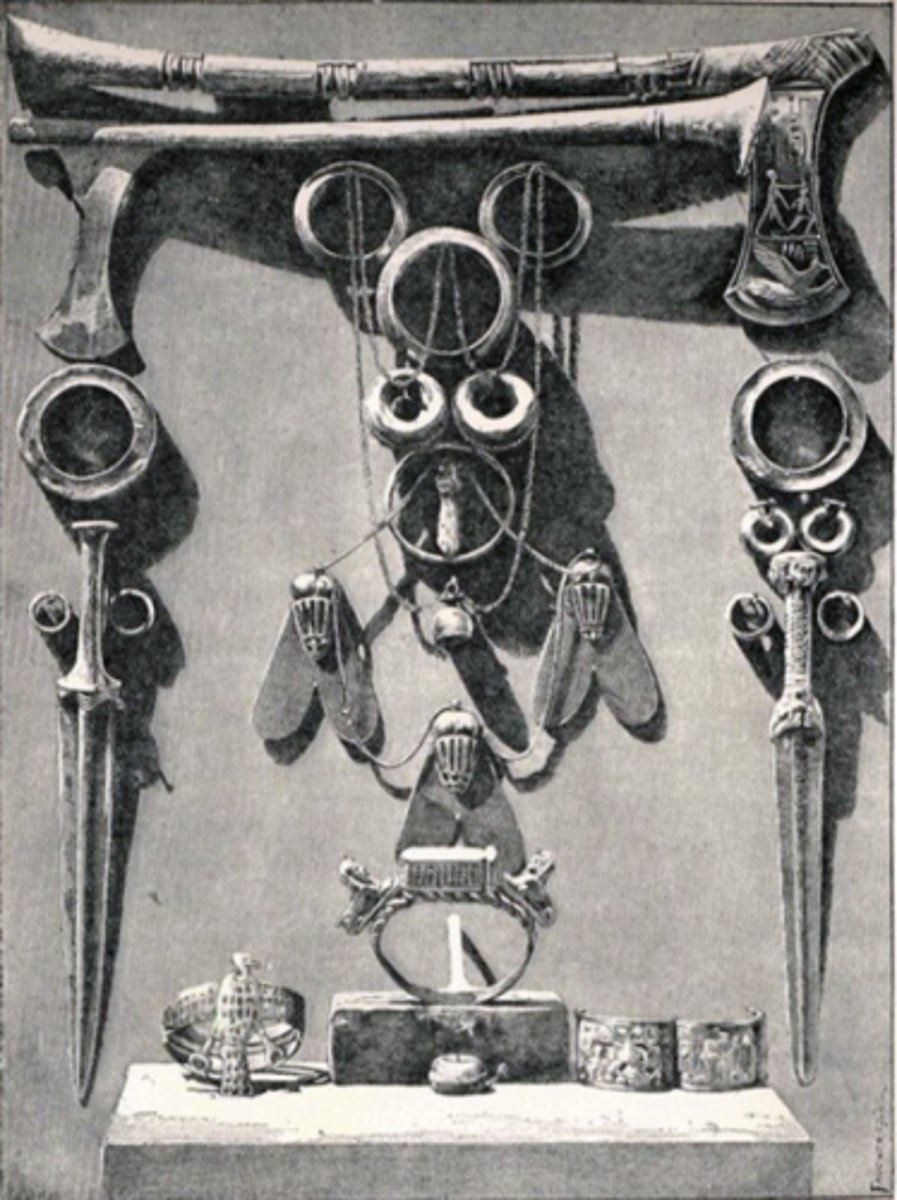
Hatshepsut and Amun, top of obelisk, carved on limestone, Karnak, 18th dynasty, New Kingdom
- Kneeling king in front of a god
- Wearing a new crown, blue cap associated with war
- Hatshepsut (female king) being honored/confirmed as king by the God Amun
- You know that it is the god Amun because of the really tall crown
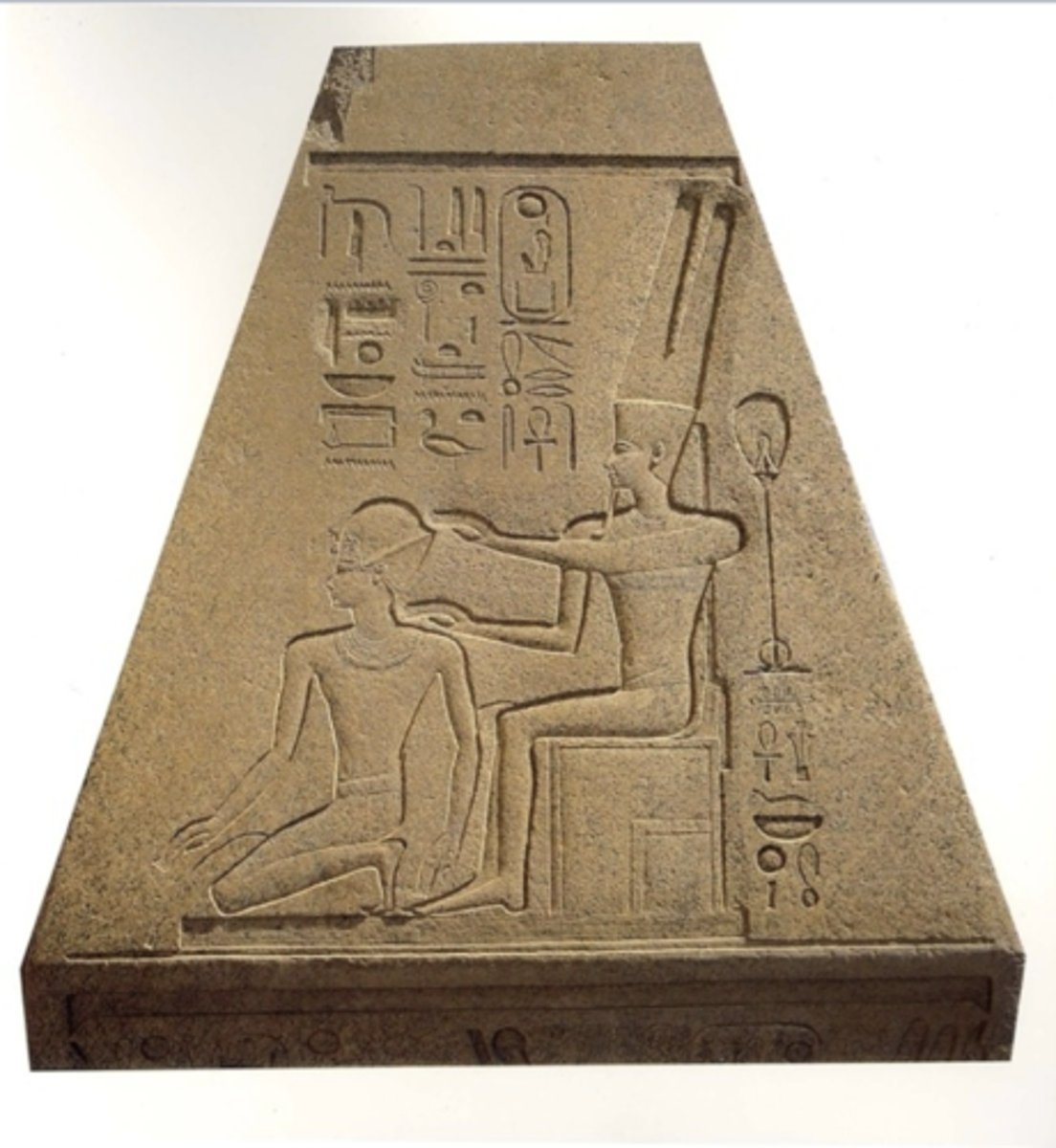
Karnak temple, stone, Thebes, started in Middle Kingdom, grows in New Kingdom
- started in the Old Kingdom, being expanded every single reign in the New Kingdom

divine birth of Hatshepsut, Deir el-Bahri, 18th dynasty, New Kingdom
- Queen Hatshepsut's mom is sitting with the god Amun\
- They are consummating their love and Amun is giving life to the mother
She is saying that she is the actual daughter of Amun
- People believe she depicts this because she is a woman and has to work harder to protect her right to rule, but this motif is continued later in Egypt, indicating that it has nothing to do with gender but is instead a new way of displaying power and right to rule as an Egyptian King
- Following image has Hatshepsut's pregnant mom being led away by two gods to give birth
- Reconceptualization of kingship
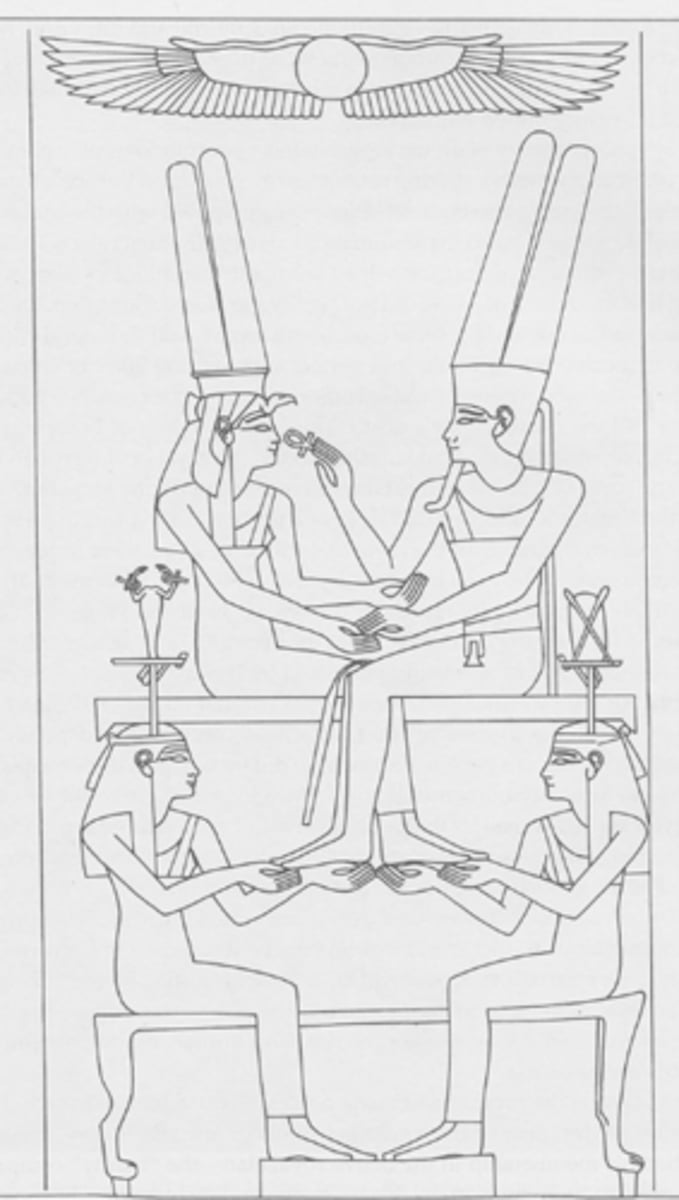
Valley of the Kings, El-Qurn Peak, Thebes, royal cemetery in the New Kingdom
- Royal tombs decorated with mythological images of the afterlife
i.e. journey of the sun god through the night
- Important for this to be in the tomb so that the king could be reborn every night
- Tombs carved into/hidden in the rock base
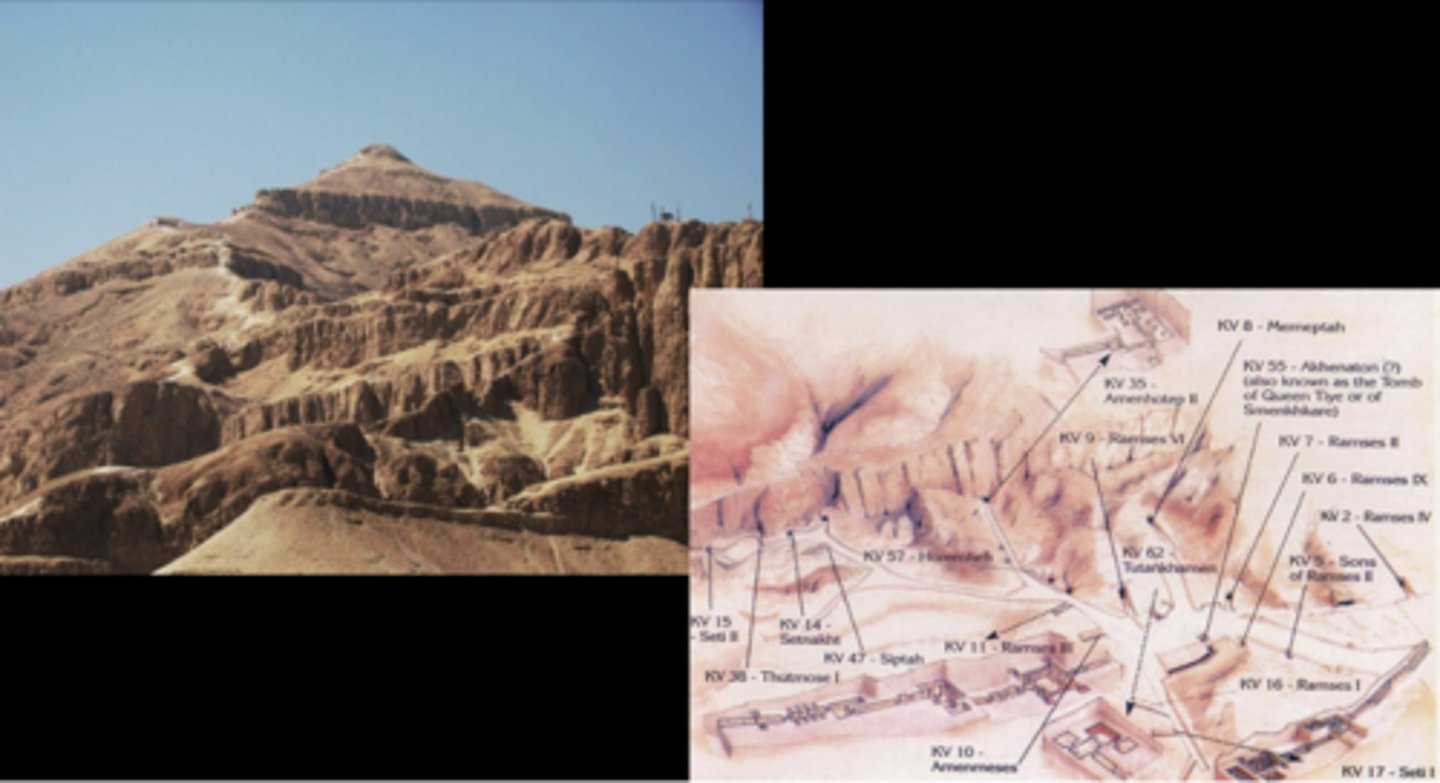
Colossi of Memnon, quartzite, Kom el-Hetan, mortuary temple of Amenhotep III, 18th dynasty, New Kingdom
- Amenhotep III = most powerful king of 18th dynasty
- Models a lot of his reign after Hatshepsut's
- Changes in art, depiction of king, prefers huge monuments
- Massive building program
- Largely a peaceful king with a peaceful reign
- Celebrates 3 Heb Seds (ramping it up in terms of displaying his power)
- Inherits a huge empire from Thutmose III
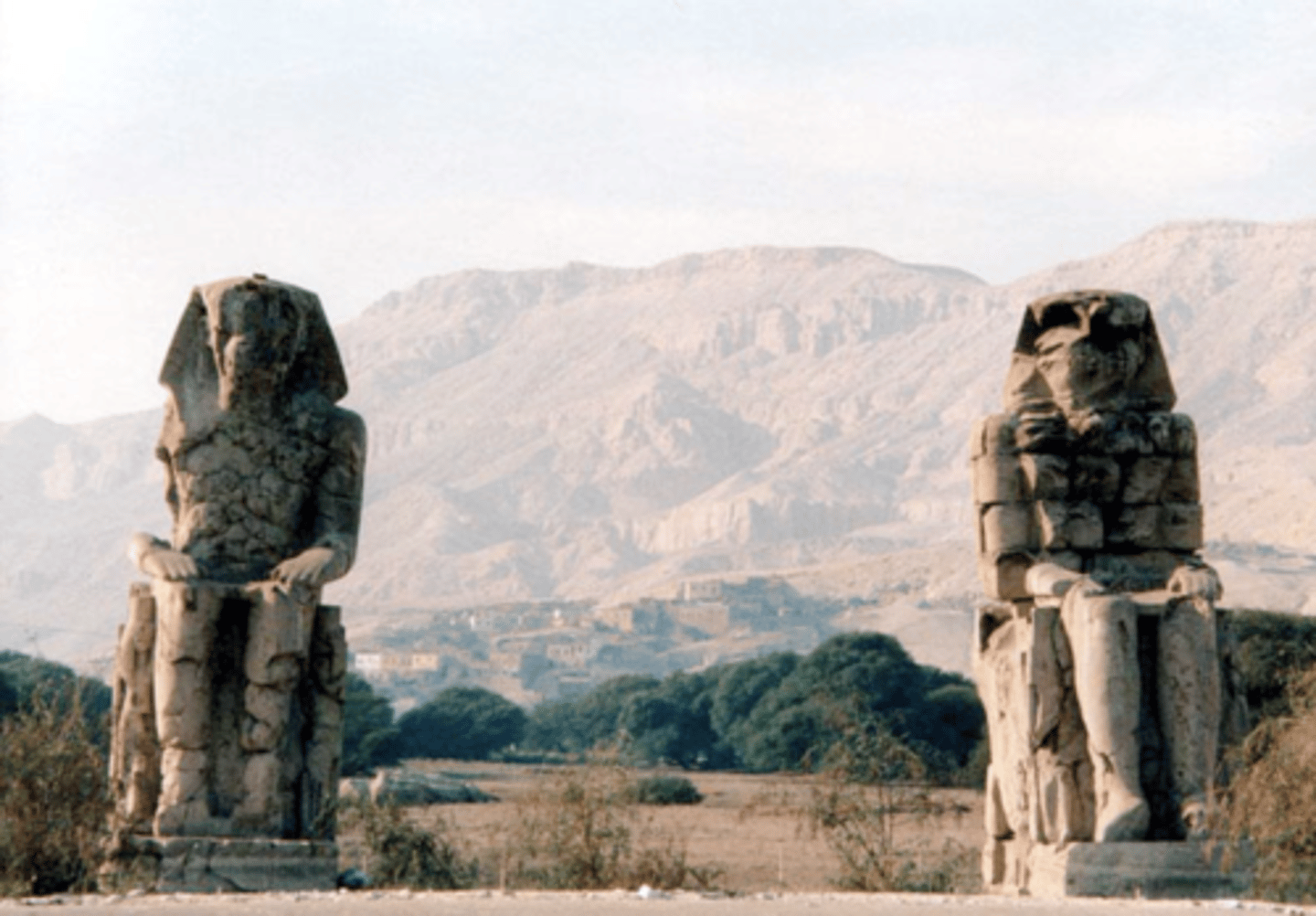
Colossus of Akhenaten, sandstone, Karnak, 18th dynasty, New Kingdom
- Elongated features
- Body shape is bizarre (curvature) and does not look Egyptian
- Blending gender roles, encompassing both the feminine and masculine creative principles
- Connecting himself to Aten who has this characteristic of dual gender roles
- Trying to show that he is a god
- Probably still an idealization
- Changing relationship between the king and the god
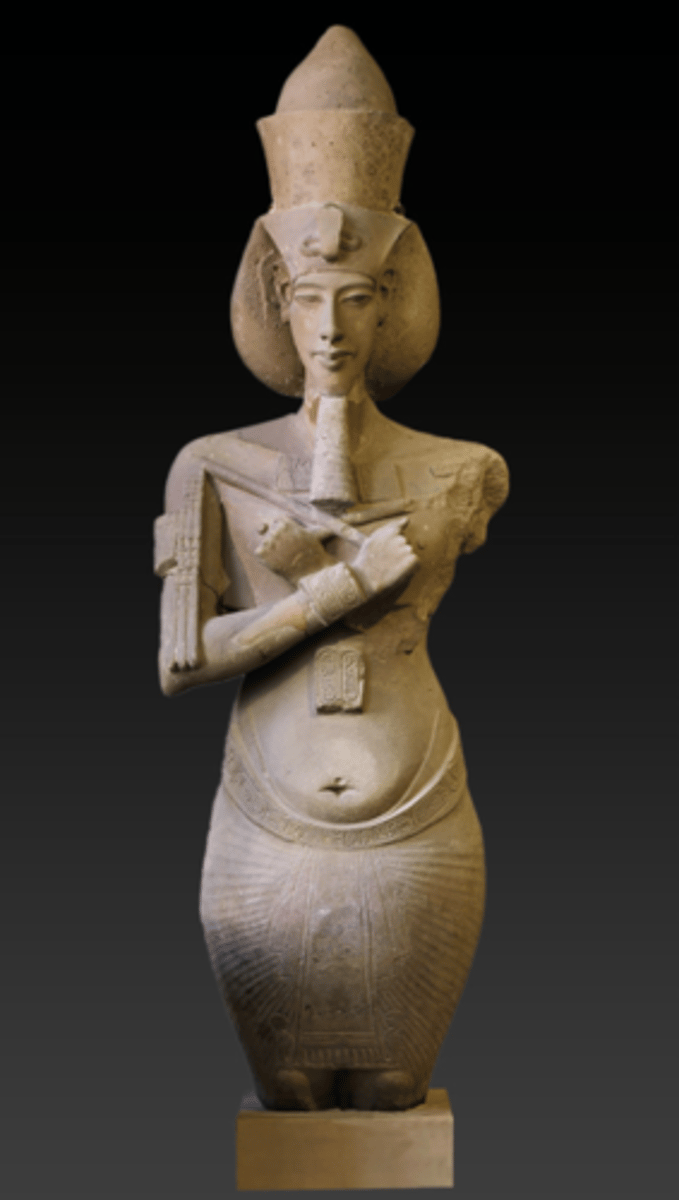
Sculptors Bek and Men offering to Akhenaten and Amenhotep III, rock carving, Aswan, 18th dynasty, New Kingdom
- Proves that Akhenaten's depiction is idealized by showing that the sculptors did things differently depending on which king they were serving
- Amenhotep's side is very traditional
- Akhenaten's side is bizarre with sun disk, and he is depicted strangely
- Clearly reflects a shift in style from the early New Kingdom to the Amarna period
- Symbolic of a religious shift
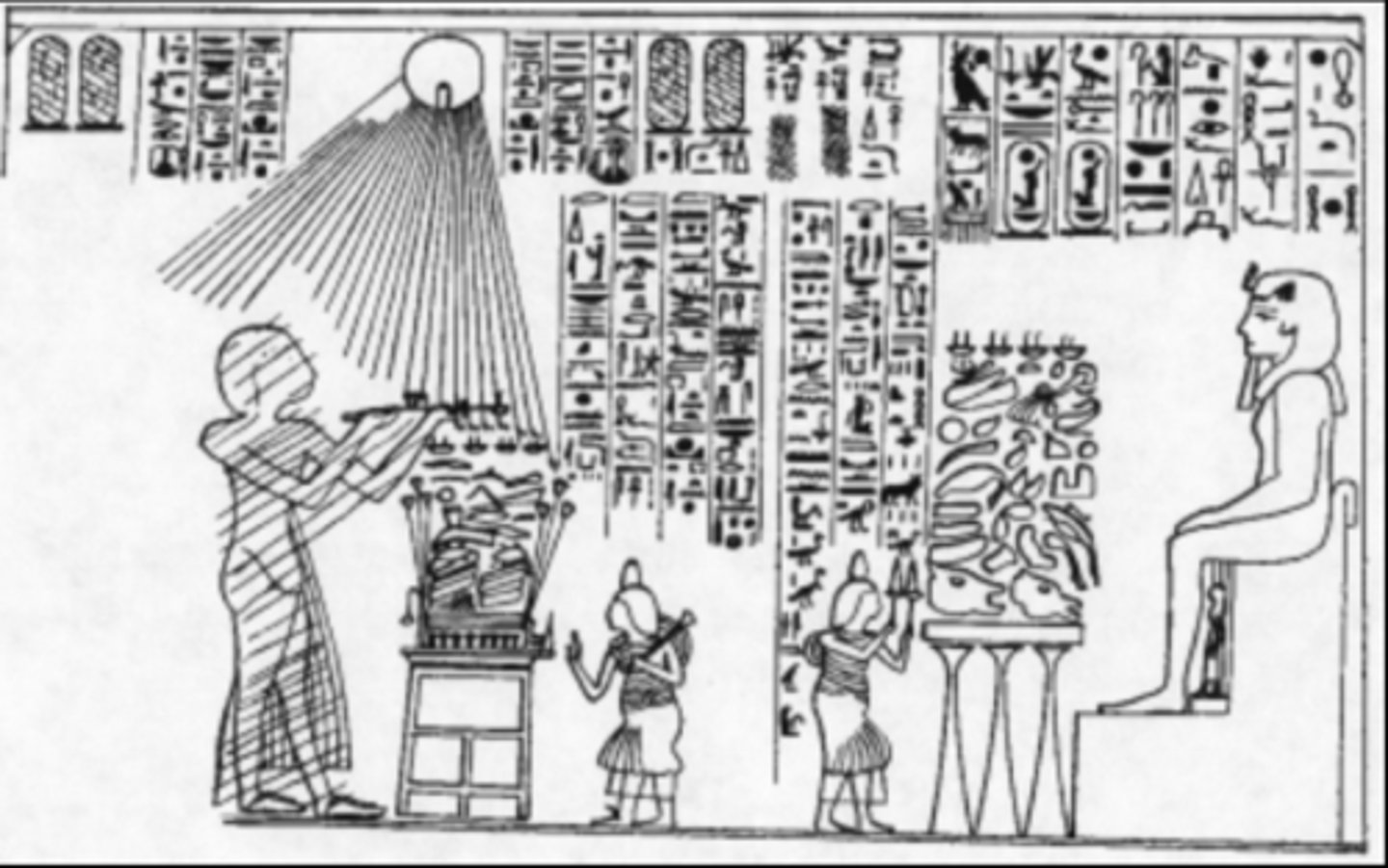
Amarna princesses, King's house, paint on plaster, Amarna, 18th dynasty, New Kingdom
- Usually only the daughters shown in imagery
- Weird alien-like heads are typical here
- Intimate scene where the daughters seem to be playing, not common outside of the Amarna period
- More realistic Amarna style
- For some reason, only daughters displayed in art, not sons
- From a palace

Stela from garden shrine, carved stone, Amarna elite house, 18th dynasty, New Kingdom
- Proportions are super weird
- Found in a shrine at an elite house
- Depicts royal family
Aten extending little hands to royal family
- In order to get to the Aten, an Egyptian would need to worship the king and the queen who work as intermediaries between humans and the Aten
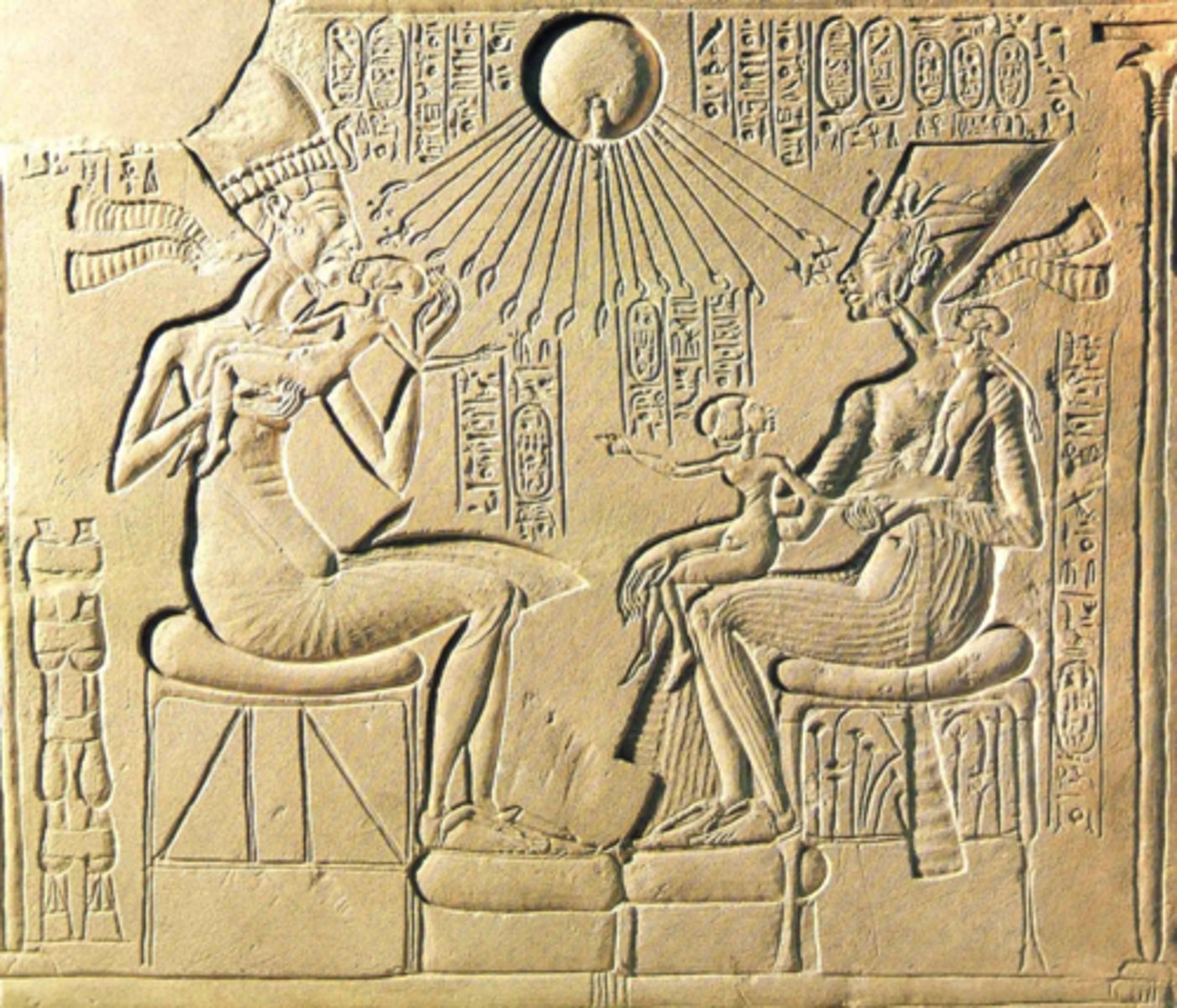
Amun and king (Tutankhamun or Horemheb), limestone, Thebes, 18th dynsty, New Kingdom
- Very clear decision to go back to traditional ways of displaying people and gods
- Getting rid of his father's memory, rejecting his father's religion, giving power back to Amun and displaying Amun larger than himself to display Amun's greater importance
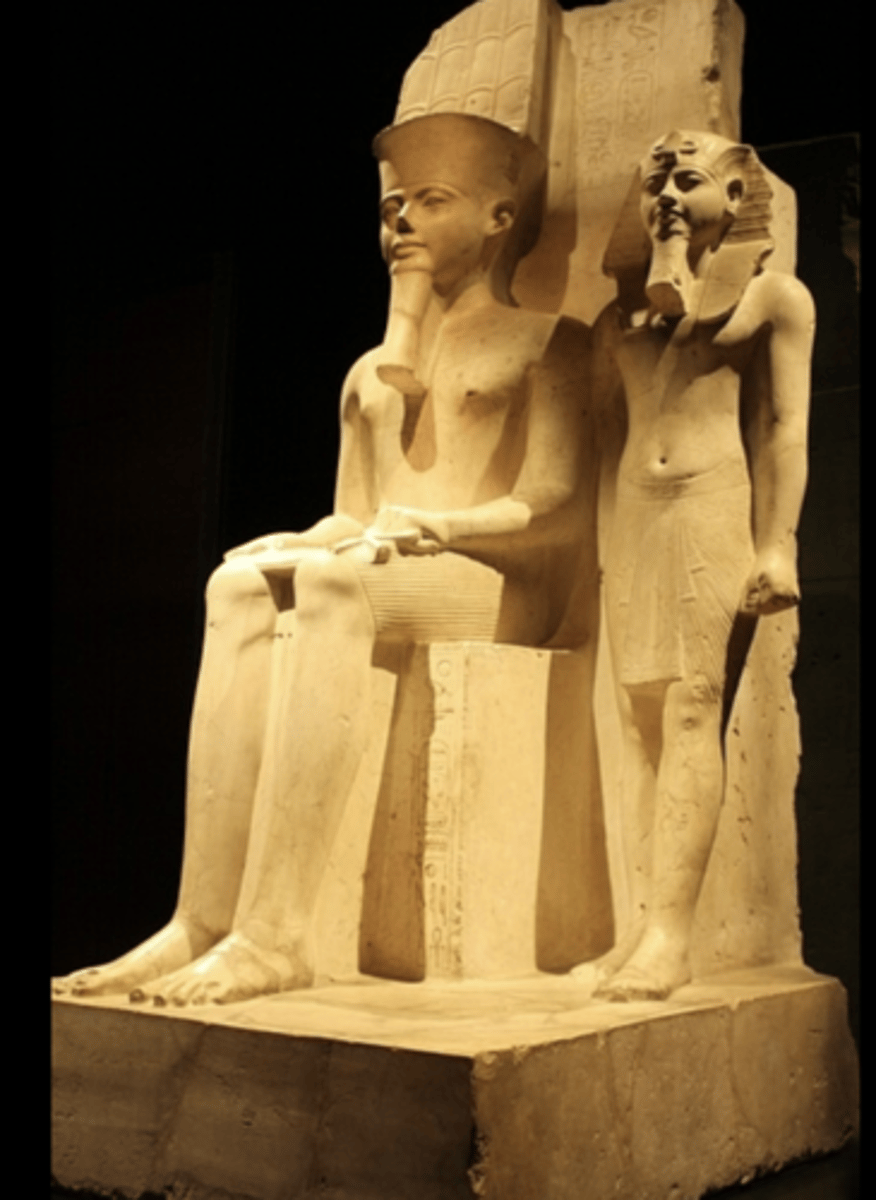
funerary mask of Tutankhamun, gold and precious stone, Valley of the Kings, 18th dynasty, New Kingdom
- Has all of the symbols of royalty (false beard, headdress, uraeus, etc...)
- Being tied to both kingship and divinity
- Curly beard = divinity
- Straight beard = kingship
- Gold is the color of the skin of the gods, and tut has it here as well
- When you die you become a god to help you survive the afterlife
- Dried flower garlands that seem to have been added to the coffin during the funeral also found
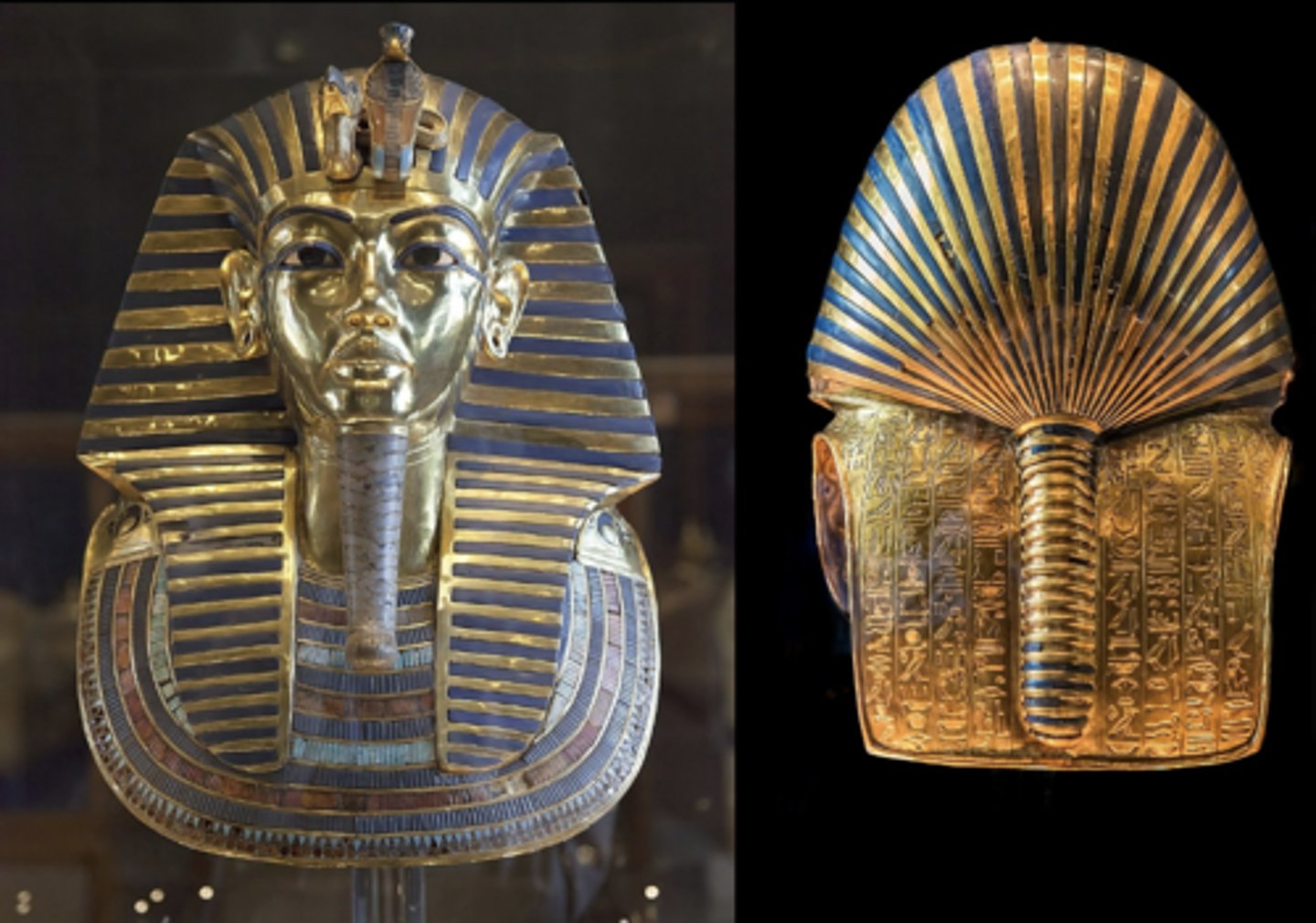
Battle of Kadesh temple relief, carved stone, Ramesseum, mortuary temple of Ramses II, Thebes, 19th dynasty, New Kingdom
- King on a chariot trampling people, chaos surrounding him
- King is attacking a fortress/city
- Not historically accurate
- He did not actually win any battles

Ramesseum, Mortuary temples of Ramses II, Thebes, 19th dynasty, New Kingdom; 1 = sanctuary, 2 = hypotstyle hall, 3 = open courtyard(s)
- 3 main parts to new kingdom temples, tied to the story of creation (world = ocean and land started as a mound that rose from it)
- 1 = Sanctuary
Meant to represent ocean (nu)
2 = Hypostyle hall: really big space filled with columns
Meant to represent first march where life first began
Columns are really big and there are inscriptions going up the entire columns
Inscriptions directed towards the gods, not meant for human eyes
Most columns would have been painted
Column tops look like lotus flowers, columns are plant-shaped
3 = One or more open courtyards
Area of the temple that would have been accessible to a larger number of people
No roof
Pylon = monumental facade with two towers that slope inwards, type of gateway
Built form of a hieroglyph, which is a drawing of the horizon, or the sun rising between two mountains
Had scenes of the kings sitting in front of the Gods or images of the kings smiting
Main body of the temple is built of stone, but the rest is built of mudbrick (storehouses for grain, slaughterhouses, houses for priests)
Temple performed different functions)
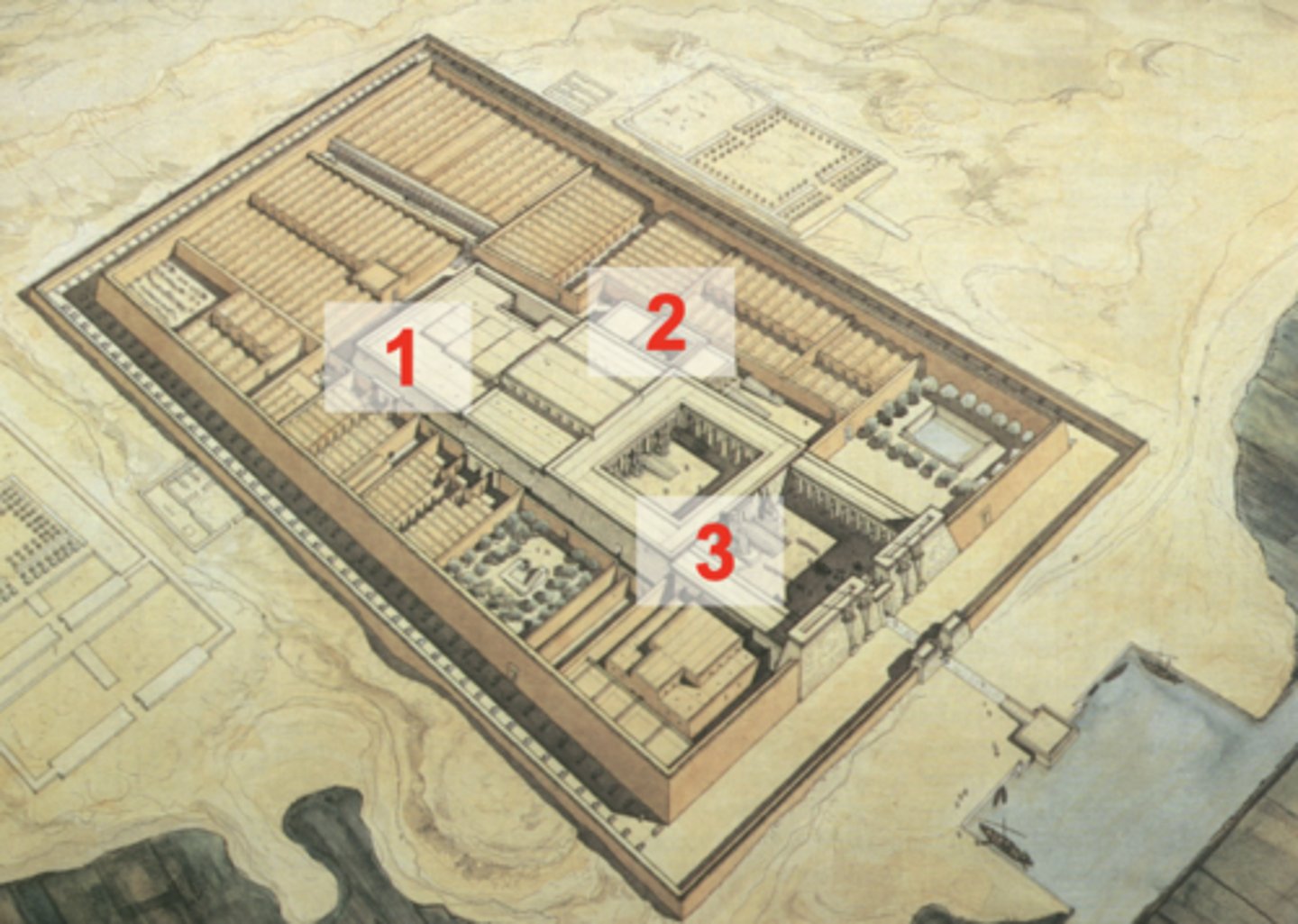
Sety I presenting prisoners and booty from the Levant to Amun, Mut, and Khonsu, carved stone, Karnak, 19th dynasty, New Kingdom
- Amun sitting on a throne in front of his wife and son
- Sety is bringing gifts and presenting captives to these gods
- Demonstrates the types of booty that would be brought back to Egypt after battle (captives, animals, objects, etc...)
- Pretty clear statement of the power of the king, but in service to the gods
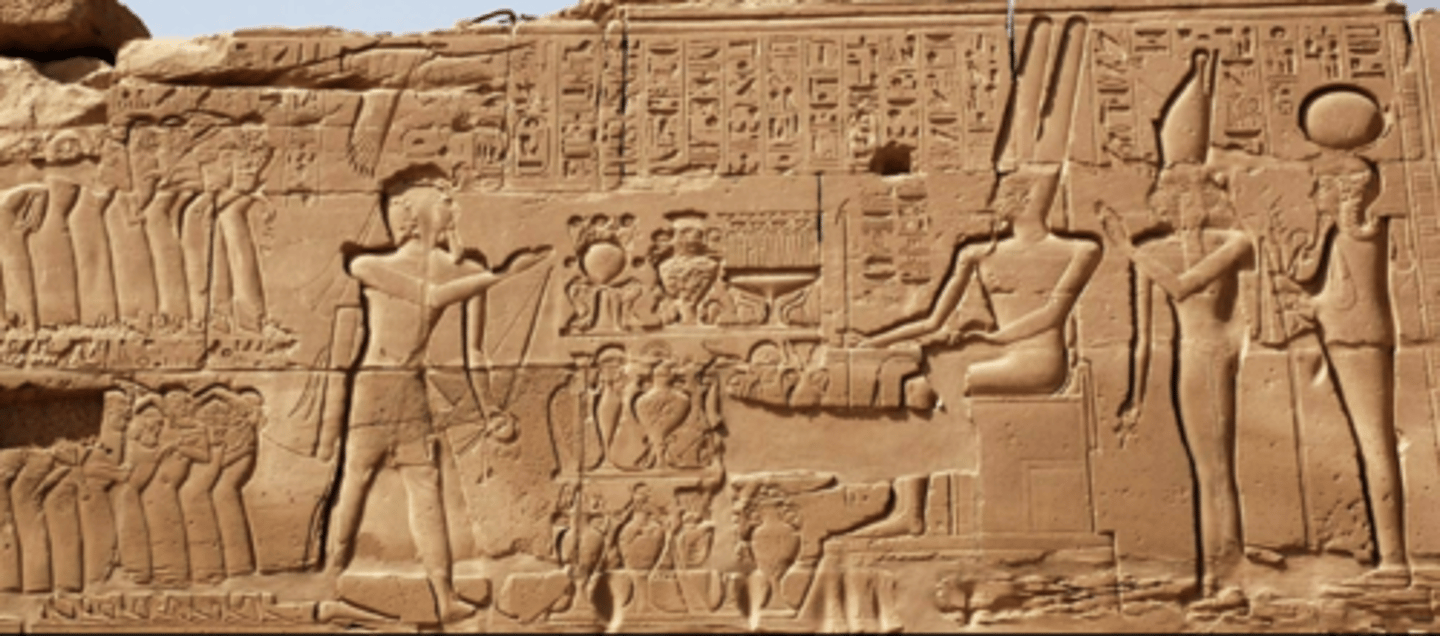
Abu Simbel temple, sandstone, Ramses II, Nubia, 19th dynasty, New Kingdom
- Decorated it with images of war
- Countless giant images of Ramesses inside as well
- In the back, Ramesses is sitting next to three gods, and he is in the same scale as them
- Depicting himself/likening himself to a god
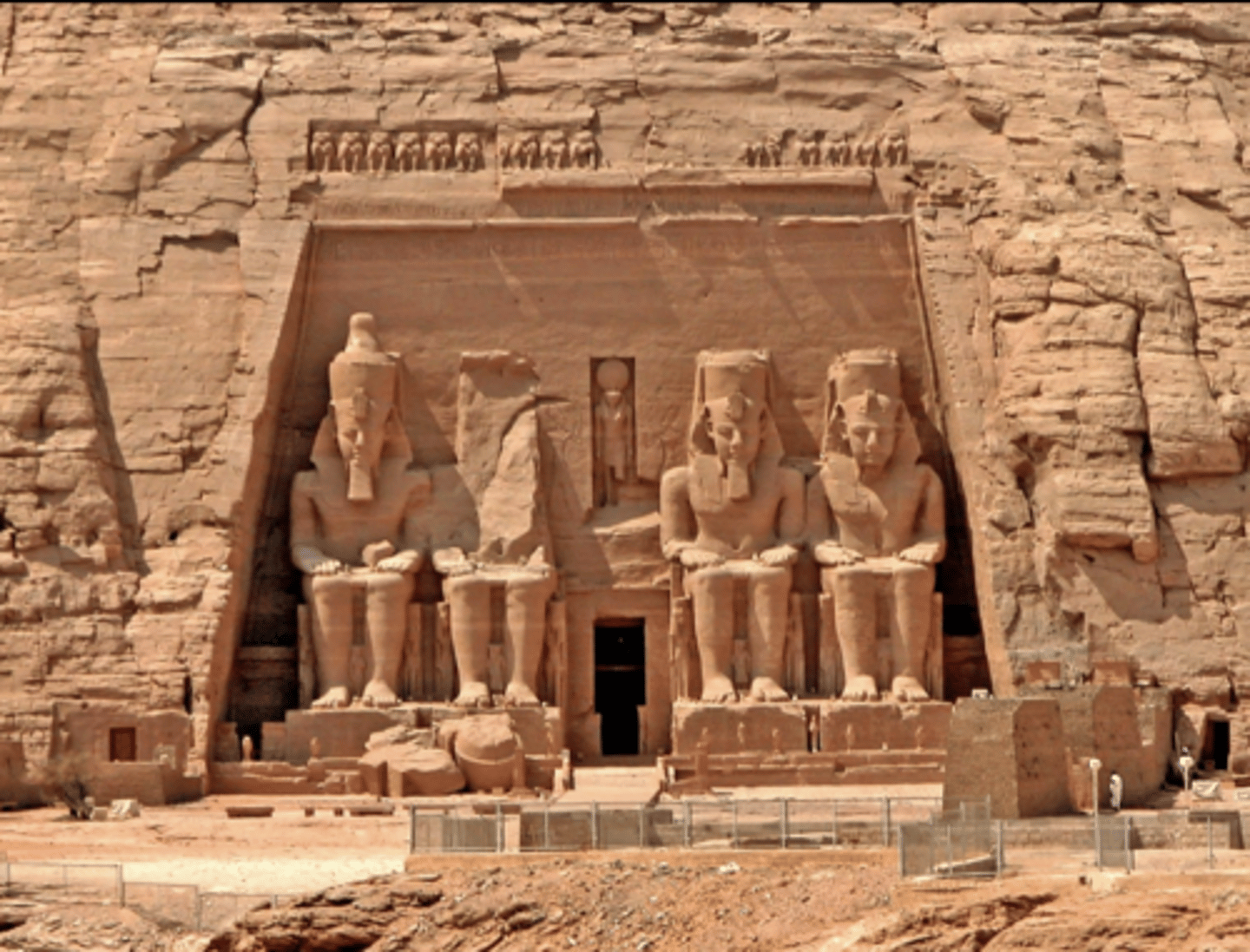
Deir el-Medina, founded in 18th dynasty, peaked in 19th dynasty, Thebes, New Kingdom
- Both this town and Lahun were state-built towns for workmen who would build the royal tombs
- All of the houses have similar/identical architectural plans because they were built by the state and not by the individual workmen, although the workmen could modify their houses later on
- Ancestor busts found in rooms of houses
- Smoke residue suggests ritual involves bringing offerings and using incense in some way
- Close to the valley of the kings
- The necropoleis of Deir el-Medina
- Some of the non-royal workmen tombs have pyramids
- These people are decorating the royal tombs, so they are coming into contact with the imagery and ideas of royal tombs and are adding these into their own burials
- One tomb has a deity holding a knife standing at the entrance of the burial chamber
- Protecting the burial chamber
- Parallel to royal tombs
- First instance of king depicted in a nonroyal tomb, becomes relatively common in the New Kingdom
- West wall: Dead king (Amenhotep I, deified and becomes oracle at Deir el-Medina) with two goddesses
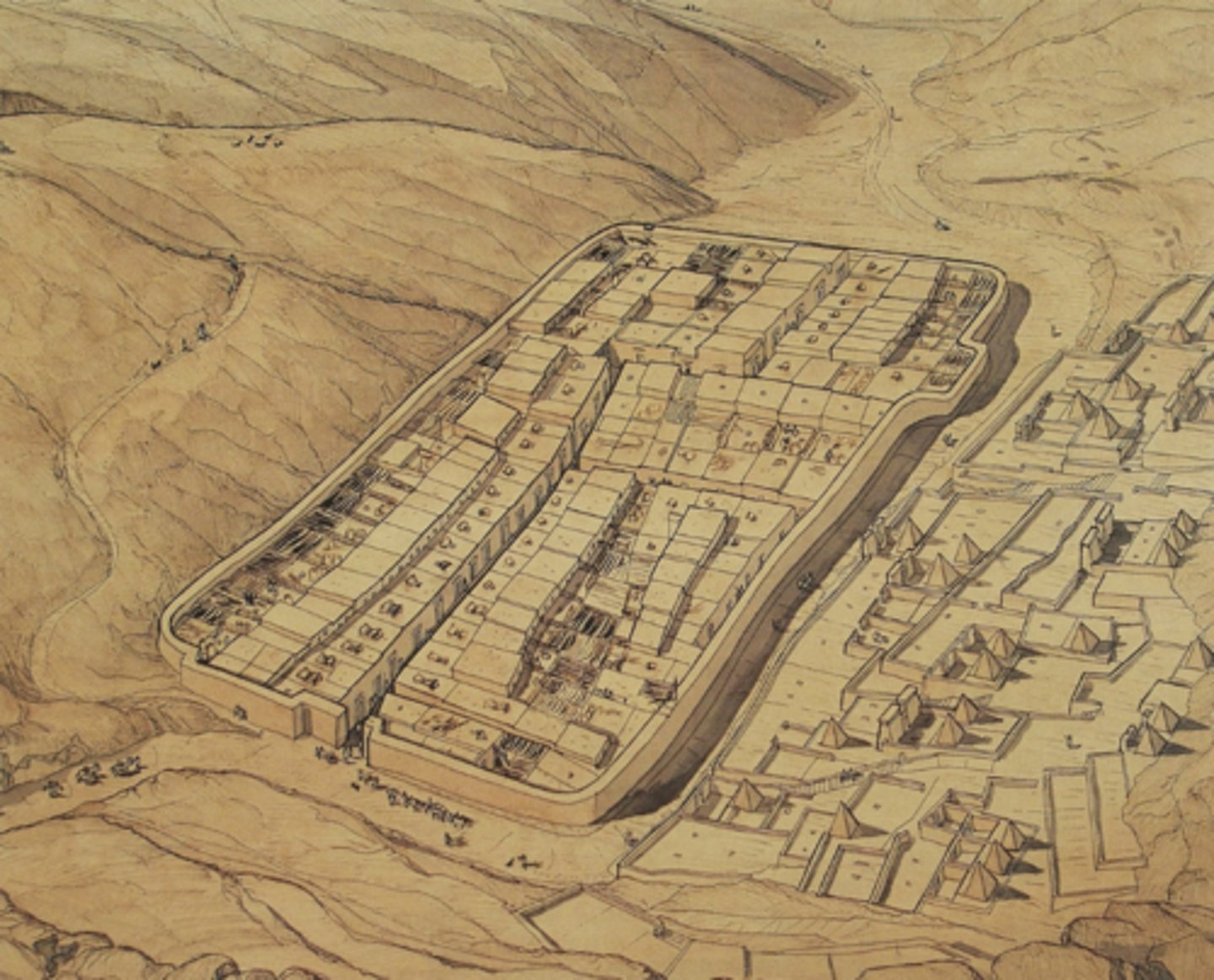
Nectanebo and Horus, dark green stone (metagreywacke), dynasty 30, Late Period
- Demonstrates that the king is inferior to the gods
- King much smaller than Horus
- Shift from fourth dynasty Khafre statue that indicates that the gods are subservient to the kings
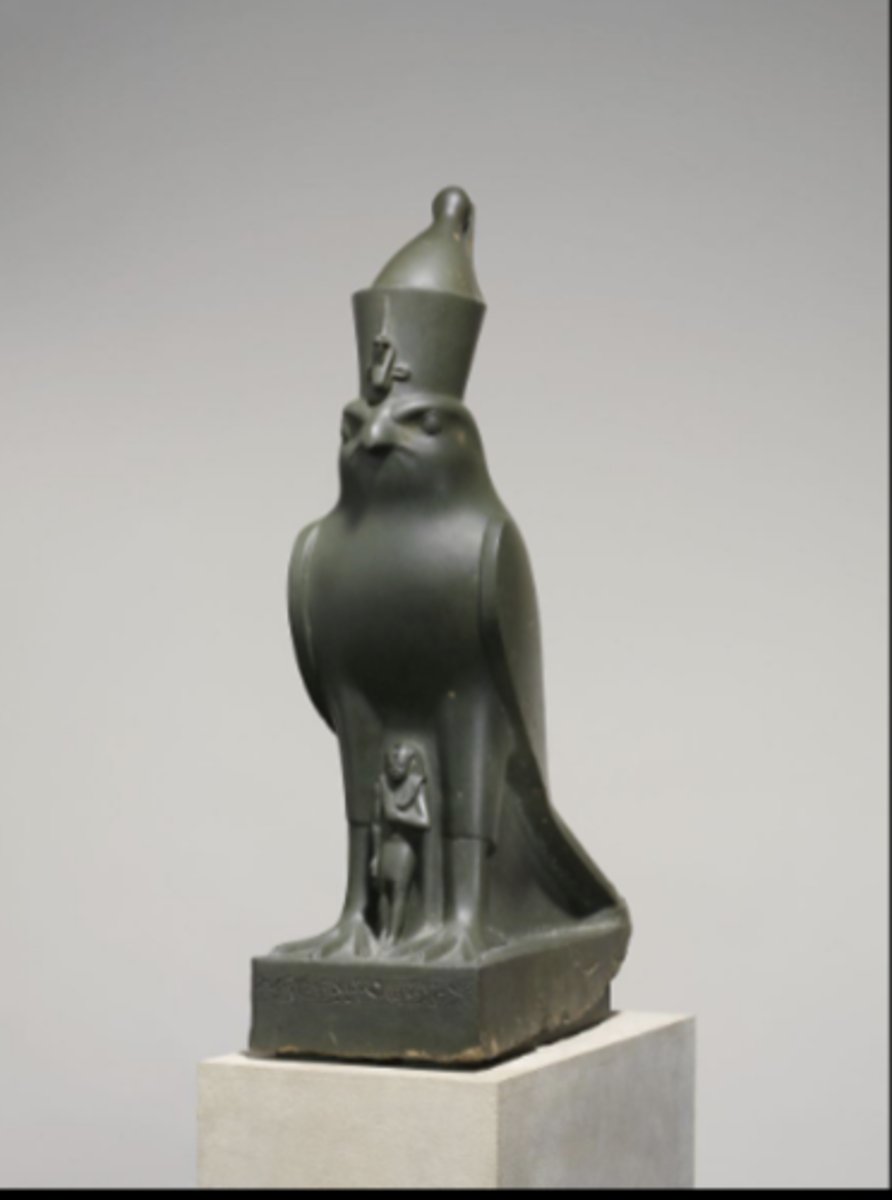
Ramses III battling the "Sea Peoples", carved stone, Medinet Habu, Thebes, 20th dynasty, New Kingdom
- Images of him fighting sea peoples and Libyans
- Hints at what will happen in the third intermediate period with foreign power coming into Egypt and taking over
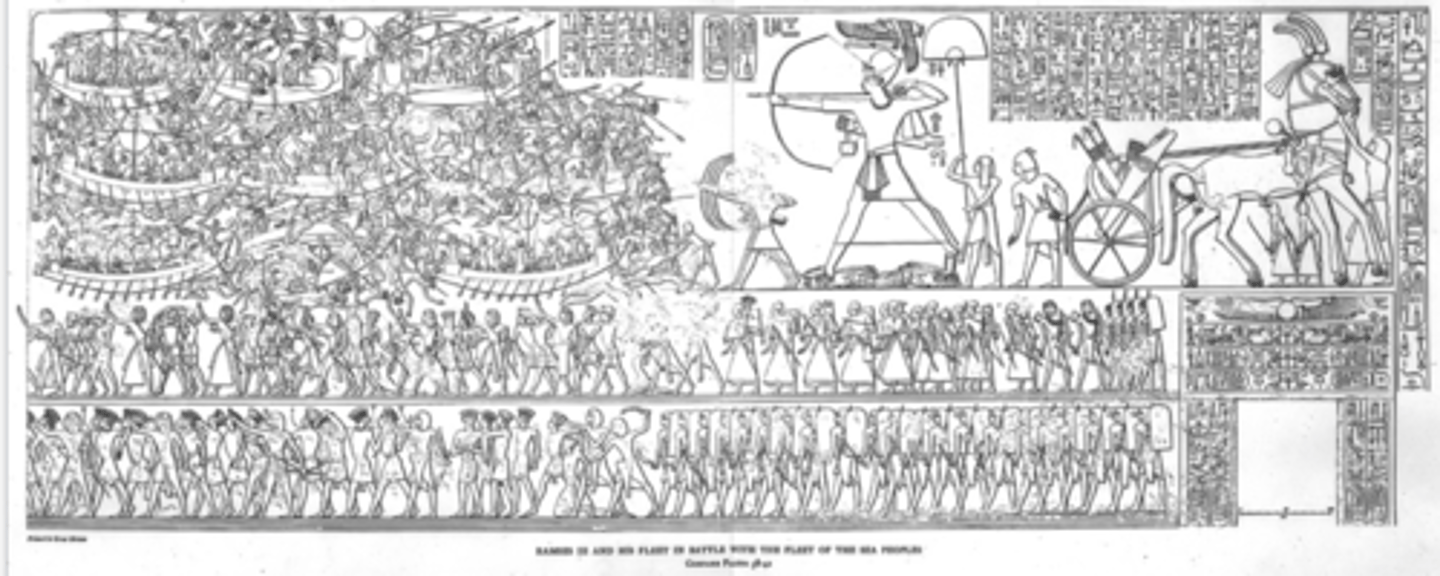
coffin and facemask of Psusennes I, 21st dynasty, gold, silver, Tanis, Third Intermediate Period
- Outer mask was gold, inner mask was silver
- Tomb not looted because it was kept inside the Amun complex for protection
- Tied to new subjugation of the kings to the gods
- Lots of elaborate objects, very rich burial
- Even if Egypt is suffering economically, kings are still able to amass enough resources to have an elaborate burial

"Libyan Family Scene" of Taharqa, carved stone, Kawa Temple, Nubia, 25th dynasty, Third Intermediate Period
- Libyan family with head of family being trampled by the sphinx and other family members covering themselves, cowering in fear, attempting to protect themselves
- Display of royal power against the Libyans
- Not historical, same Libyan family being named in each example of these family scenes
- Reintroduced when the Nubians take over Egypt and defeat the Libyans
- Originally Egyptian and Taharqan (Nubian) finds it and adopts it
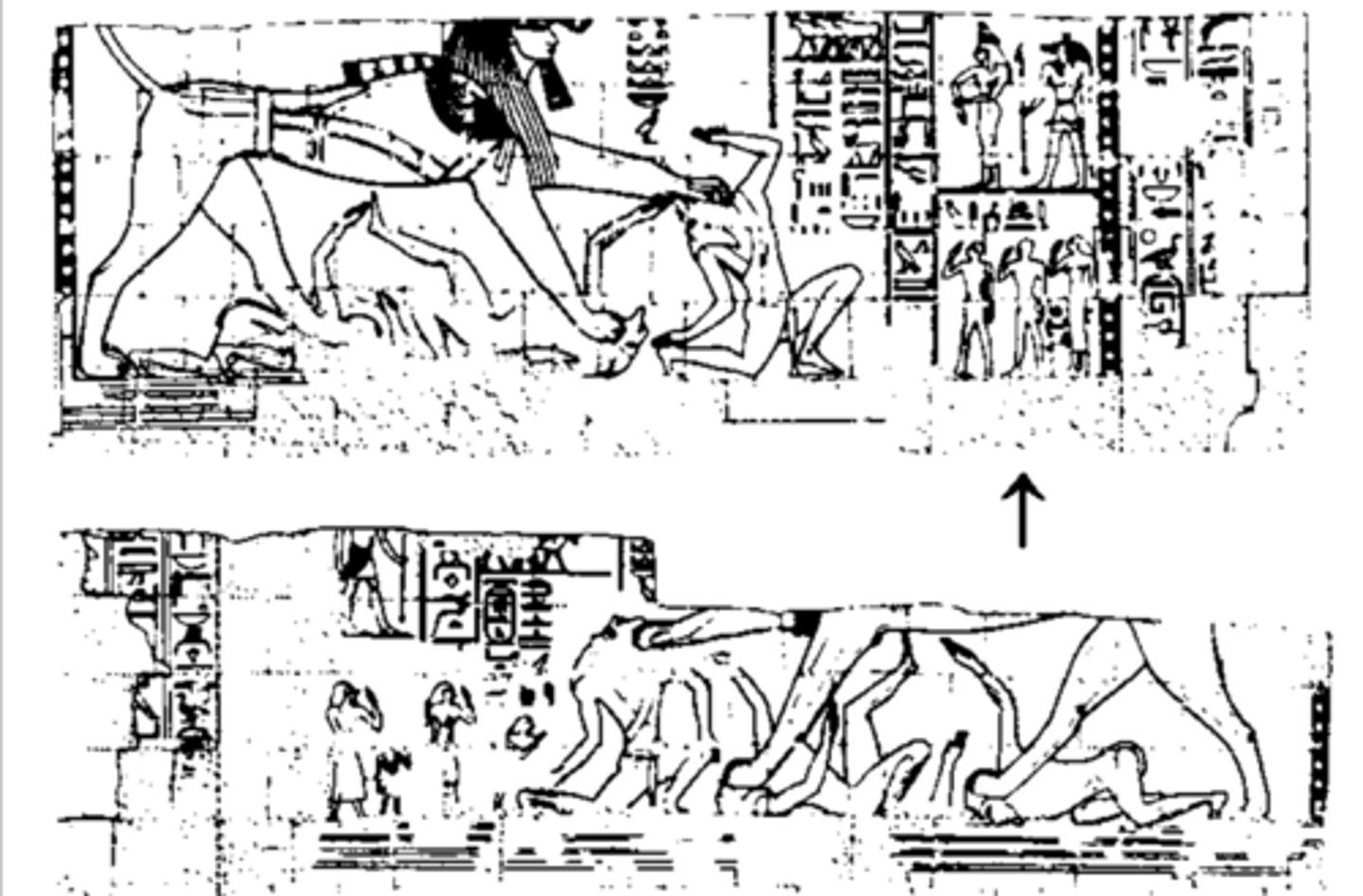
Mummy Portrait, lime, wood, stucco, wax, gold, lac(?), Hawara, Fayum Oasis, 150-170 CE, Roman Period
- New trend for burials that appeared after the Ptolemaic period
- Fusion of roman and Egyptian culture
- Hyper realistic portraits almost always in ¾ view
- Suspected to be made after the person died
- Clothing and style reflect Greek and Roman style despite Egyptian burial style
- Similar yet different approach to mummification

Statue of Alexander the Great as Pharaoh, pink granite, c. 300 BCE, Ptolemaic Period
- Alexander trying to justify his rule in Egypt by taking on Egyptian imagery in his own statues
- Striding, headdress, clothing
- No beard, youthful look, Greek features
- Mix of both Greek and Egyptian features
- Alexander claims to be the son of the last Egyptian pharaoh and the divine son of Amun Zeus (previously Amun Re, but became associated with Zeus in the time of Greek influence)
